Dive into crystal-clear Mediterranean waters, feel the warm golden sand beneath your feet, and discover why these seven stunning coastal paradises rank among the best summer destinations in Europe for unforgettable beach adventures.
Europe’s coastline stretches over 24,000 miles, offering an incredible array of pristine beaches that rival any tropical paradise. From the dramatic limestone cliffs of Croatia to the pink sands of Greece, these seven destinations represent the pinnacle of European beach experiences. Each location combines natural beauty with unique cultural experiences, making them perfect for travelers seeking both relaxation and adventure during the summer months.
Why Europe Offers the World’s Most Diverse Beach Experiences
Europe’s beaches stand apart from other global destinations due to their incredible diversity and accessibility. Unlike many tropical locations, European coastal destinations offer rich history, world-class cuisine, and stunning architecture just steps away from pristine shores. The Mediterranean climate provides ideal conditions from May through September, with average temperatures ranging from 75-85°F (24-29°C) and minimal rainfall during peak summer months.
The continent boasts over 600 Blue Flag certified beaches, ensuring exceptional water quality and environmental standards. From the volcanic beaches of Italy to the crystal-clear lagoons of Croatia, Europe’s coastal destinations cater to every type of beach lover.
Zlatni Rat, Croatia: The Shape-Shifting Paradise
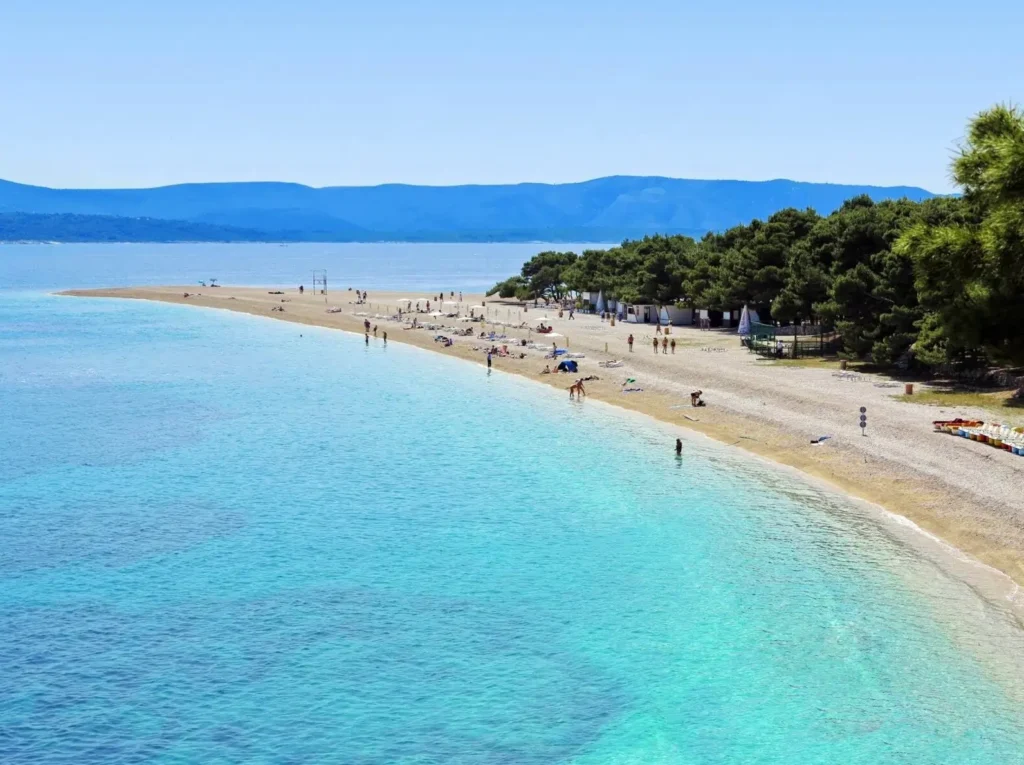
Zlatni Rat, often called the Golden Horn, represents one of Croatia’s most photographed beaches and deserves its place among the best summer destinations in Europe. This unique V-shaped beach on Brač Island constantly changes its form due to shifting winds and currents, creating an ever-evolving natural masterpiece.
What Makes Zlatni Rat Extraordinary
The beach extends 634 meters into the Adriatic Sea, composed of fine white pebbles that create impossibly clear turquoise waters. Pine forests provide natural shade along the shoreline, while the Vidova Gora mountain backdrop offers breathtaking panoramic views. During my visit last summer, I witnessed firsthand how the beach’s tip literally shifts direction throughout the day – a phenomenon that never fails to amaze both first-time visitors and seasoned travelers.
The western side offers calm waters perfect for families with children, while the eastern shore attracts windsurfers and kitesurfers due to consistent winds. Beach clubs like Auro provide excellent dining and cocktail service, making it easy to spend entire days here without leaving paradise.
Getting There and Best Time to Visit
Zlatni Rat is accessible via a scenic 30-minute walk from the charming town of Bol, or by parking at the designated area just 10 minutes from the beach. The optimal visiting period runs from June through September, with July and August offering the warmest waters but larger crowds.
Cala Goloritzè, Sardinia: Italy’s Hidden Gem
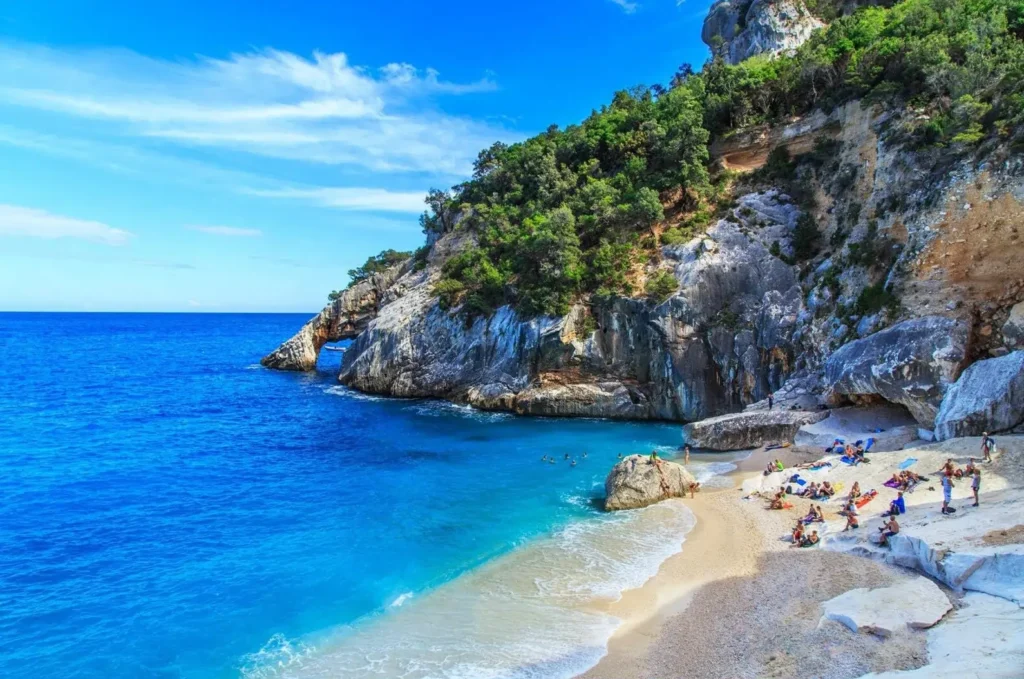
Sardinia’s east coast harbors some of Europe’s most spectacular beaches, with Cala Goloritzè standing as the crown jewel. This UNESCO World Heritage site combines pristine natural beauty with dramatic limestone formations that seem almost otherworldly.
The Untouched Beauty of Sardinia’s Coast
Cala Goloritzè features snow-white pebbles meeting waters so clear you can see the bottom at 20 feet depth. The beach sits beneath towering limestone cliffs, including the famous 486-foot Monte Caroddi needle – a favorite challenge for rock climbers. What struck me most during my visit was the complete absence of commercial development; this beach remains exactly as nature intended.
The journey to reach Cala Goloritzè adds to its mystique. Visitors must either take a boat tour or hike the challenging but rewarding Cala Goloritzè Trail. The hour-long trek through Mediterranean scrubland culminates in a breathtaking reveal of this hidden paradise.
Planning Your Visit
Access is limited to protect the fragile ecosystem, with boat tours operating from Cala Gonone between May and October. The hiking trail requires sturdy footwear and plenty of water, but the reward of experiencing one of Europe’s most pristine beaches makes every step worthwhile.
Elafonissi Beach, Crete: The Pink Sand Wonder
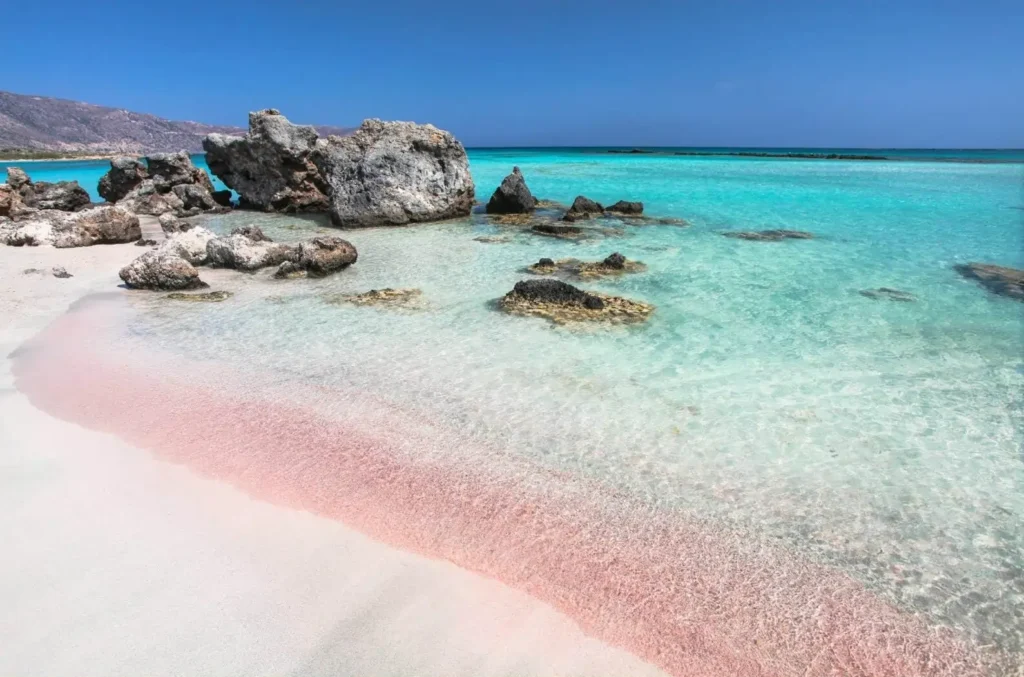
Few beaches in Europe offer the unique experience of Elafonissi Beach, where pink-tinged sand meets some of the clearest waters in the Mediterranean. This natural phenomenon results from crushed coral and seashells mixing with the pristine white sand, creating a sunset-colored shoreline that changes hue throughout the day.
A Natural Paradise in Southwest Crete
Elafonissi operates as both a beach and nature reserve, protecting its fragile ecosystem while welcoming visitors. The shallow lagoon connecting the beach to Elafonissi islet allows visitors to walk across during low tide, exploring both sides of this natural wonder. During my August visit, the water remained refreshingly cool despite air temperatures reaching 32°C (90°F).
The beach offers excellent snorkeling opportunities, with underwater grass beds supporting diverse marine life. Rare plants and flowers dot the surrounding landscape, including endemic species found nowhere else in Europe.
Sustainable Tourism at Its Best
Elafonissi demonstrates how popular destinations can balance tourism with environmental protection. Visitor numbers are managed through limited parking and natural barriers, ensuring the beach never feels overcrowded. The absence of large-scale commercial development maintains the area’s pristine character.
Ses Illetes, Formentera: Spain’s Caribbean Paradise

Formentera’s Ses Illetes beach earned its reputation as the “Caribbean of Spain” through pristine white sand and impossibly turquoise waters. This extraordinary beach consistently ranks among Europe’s most beautiful, offering a true escape from the ordinary.
Pure Paradise in the Mediterranean
Ses Illetes stretches along the narrow Trucador Peninsula, creating a unique geography where beaches face both north and south. The northern shore offers calmer conditions perfect for swimming and sunbathing, while the southern side attracts water sports enthusiasts. What makes this beach truly special is the water clarity – visibility extends up to 30 meters on calm days.
The beach’s infrastructure balances comfort with environmental sensitivity. Several beach bars provide refreshments and equipment rentals, while wooden boardwalks protect the fragile dune ecosystem. During peak season, arriving early morning or late afternoon offers the best experience with fewer crowds and spectacular lighting for photography.
Island Life at Its Finest
Formentera’s relaxed pace and bohemian atmosphere create the perfect backdrop for a beach-focused vacation. The island’s bike-friendly culture encourages sustainable exploration, with dedicated paths connecting different beaches and villages. Local seafood restaurants serve freshly caught fish just steps from the sand, creating an authentic Mediterranean dining experience.
Praia da Marinha, Algarve: Portugal’s Golden Coast
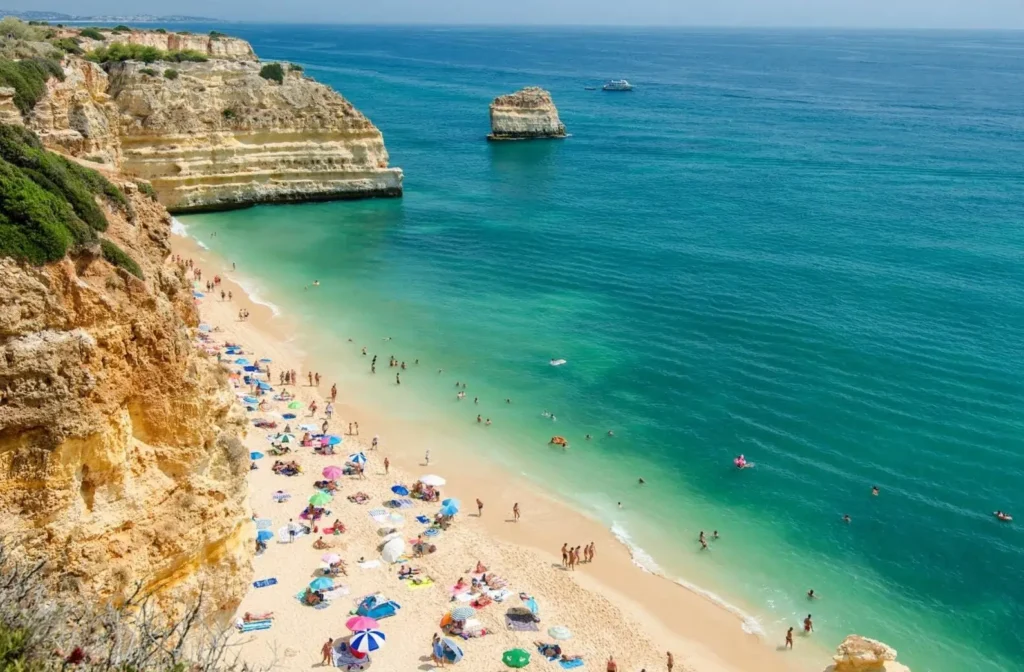
Portugal’s Algarve region hosts some of Europe’s most dramatic coastal scenery, with Praia da Marinha representing the perfect combination of natural beauty and accessibility. This beach showcases the region’s famous golden limestone cliffs alongside crystal-clear Atlantic waters.
Geological Marvels Meet Ocean Perfection
Praia da Marinha’s distinctive rock formations result from millions of years of erosion, creating natural arches, caves, and sculptural cliffs that frame the beach. The protected cove offers excellent swimming conditions, while the surrounding clifftops provide spectacular viewpoints for photography. Walking the coastal trail reveals hidden grottoes and secluded coves accessible only on foot.
The beach earned Blue Flag certification for its exceptional water quality and environmental management. Facilities include restrooms, a seasonal beach bar, and lifeguard services during peak months, making it suitable for families while maintaining its natural character.
Exploring the Wider Algarve
Praia da Marinha serves as an excellent base for exploring the Algarve’s diverse attractions. The nearby town of Carvoeiro offers charming restaurants and accommodations, while the coastal walking trail connects multiple stunning beaches. The region’s mild climate allows for year-round visits, though summer provides the warmest ocean temperatures.
Myrtos Beach, Kefalonia: Greek Island Perfection
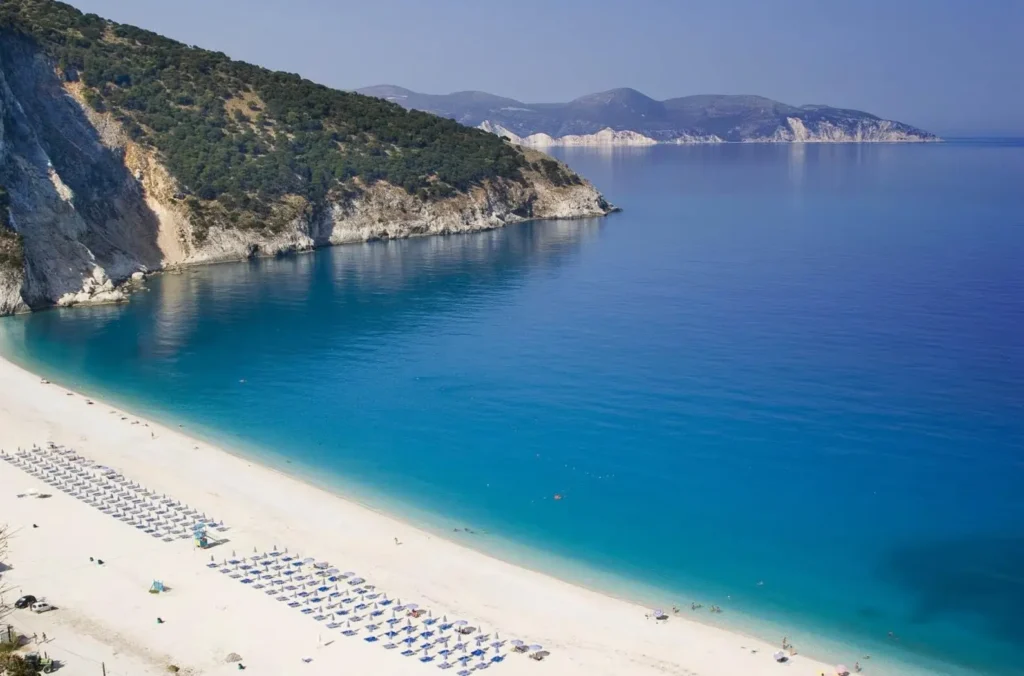
The Ionian Islands offer some of Greece’s most spectacular beaches, with Myrtos Beach on Kefalonia standing as perhaps the most photographed. This crescent-shaped beach combines dramatic mountain backdrops with electric-blue waters that seem almost artificial in their perfection.
Natural Drama on an Epic Scale
Myrtos Beach sits at the base of towering cliffs, creating a natural amphitheater of breathtaking proportions. The beach consists of white pebbles rather than sand, contributing to the water’s remarkable clarity and intense blue coloration. From the clifftop viewpoint, the entire bay spreads below like a natural masterpiece painted in shades of blue and white.
The journey down to the beach involves a winding mountain road with numerous switchbacks, but the destination justifies every turn. Once at beach level, the scale becomes even more impressive, with vertical cliffs rising hundreds of feet on both sides.
The Perfect Photography Destination
Myrtos Beach offers exceptional photography opportunities throughout the day, with different lighting conditions creating varying moods. Early morning light brings out the water’s electric blue intensity, while sunset bathes the cliffs in golden hues. The viewpoint above the beach provides the classic shot that appears in countless travel magazines and Instagram feeds.
For swimming and sunbathing, arriving early helps secure better positions and parking. The beach can become quite busy during peak season, but its generous size accommodates substantial crowds without feeling overwhelming.
Calanque d’En-Vau, France: French Riviera’s Secret
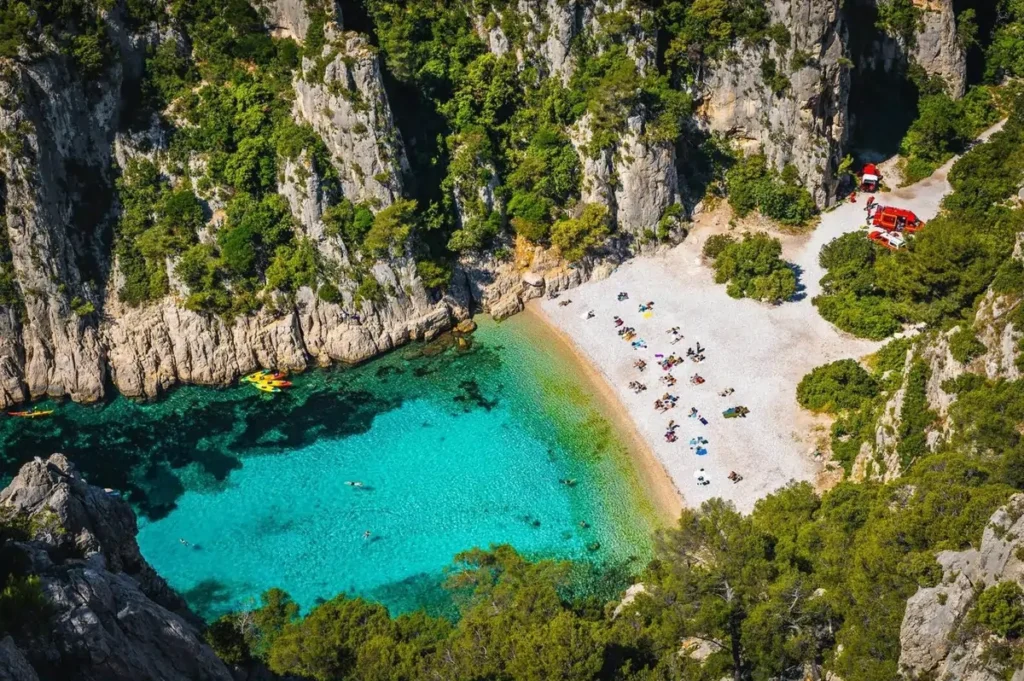
While many associate the French Riviera with glamorous resorts and crowded beaches, Calanque d’En-Vau offers a completely different experience among these best summer destinations in Europe. This hidden inlet near Marseille showcases the raw natural beauty of the Mediterranean coast.
A Hiker’s Paradise with Beach Rewards
Calanque d’En-Vau requires commitment to reach, accessible only by hiking or boat. The challenging trail descends through limestone cliffs and Mediterranean scrubland, taking approximately 90 minutes from the nearest parking area. However, this effort filters out casual visitors, preserving the calanque’s pristine character.
The secluded beach sits surrounded by white limestone cliffs rising 300 feet on three sides. Crystal-clear turquoise water provides excellent swimming and snorkeling, while the dramatic rock formations create natural shade during the hottest parts of the day. The absence of commercial development maintains the area’s wild, unspoiled atmosphere.
Protecting a Natural Treasure
The Calanques National Park protects this fragile ecosystem through strict regulations. Visitors must follow designated trails, carry out all trash, and respect wildlife habitats. These measures ensure future generations can experience this natural wonder in its current pristine condition.
Planning is essential for visiting Calanque d’En-Vau, as the park limits access during high fire-risk periods in summer. Check current conditions before traveling and bring plenty of water for the hiking portion of your visit.
Making the Most of Your European Beach Adventure
These seven destinations represent just the beginning of Europe’s incredible coastal offerings. Each location provides unique experiences that combine natural beauty with cultural richness, creating memories that last a lifetime.
Planning Your Perfect Beach-Hopping Journey
Consider visiting multiple destinations during a single trip to experience Europe’s coastal diversity. Ferry connections between Greek islands make island-hopping straightforward, while the proximity of Spanish coastal regions allows easy overland travel. Croatia’s coastal highway connects numerous stunning beaches within driving distance.
For those seeking comprehensive European travel experiences, consider exploring our guides to the Best Honeymoon Destinations in Europe for Couples and Best Cities in Europe to Visit 2025 to combine beach relaxation with cultural exploration.
Essential Planning Tips
Book accommodations well in advance for summer visits, especially in popular destinations like Formentera and Santorini. Consider traveling during shoulder seasons (May-June or September-October) for better prices, smaller crowds, and still-pleasant swimming conditions.
Pack reef-safe sunscreen to protect these pristine marine environments, and always respect local regulations regarding protected areas. Many of Europe’s best beaches exist within national parks or UNESCO sites, requiring visitor cooperation to maintain their natural beauty.
Start Planning Your European Beach Paradise
These seven magnificent beaches showcase why Europe remains the world’s premier destination for diverse, high-quality beach experiences. From Croatia’s shape-shifting Zlatni Rat to Greece’s pink-sand Elafonissi Beach, each destination offers unique natural wonders combined with rich cultural experiences you simply cannot find elsewhere.
The variety of experiences available ensures every type of beach lover finds their perfect match among Europe’s coastal treasures. Whether seeking adventure, relaxation, water sports, or simply stunning natural beauty, these best summer destinations in Europe deliver unforgettable experiences that will draw you back year after year.
Ready to experience Europe’s most spectacular beaches? Start researching flights, accommodations, and activities for your chosen destinations. The crystal-clear waters, pristine sands, and warm Mediterranean sun await your arrival at these extraordinary coastal paradises.
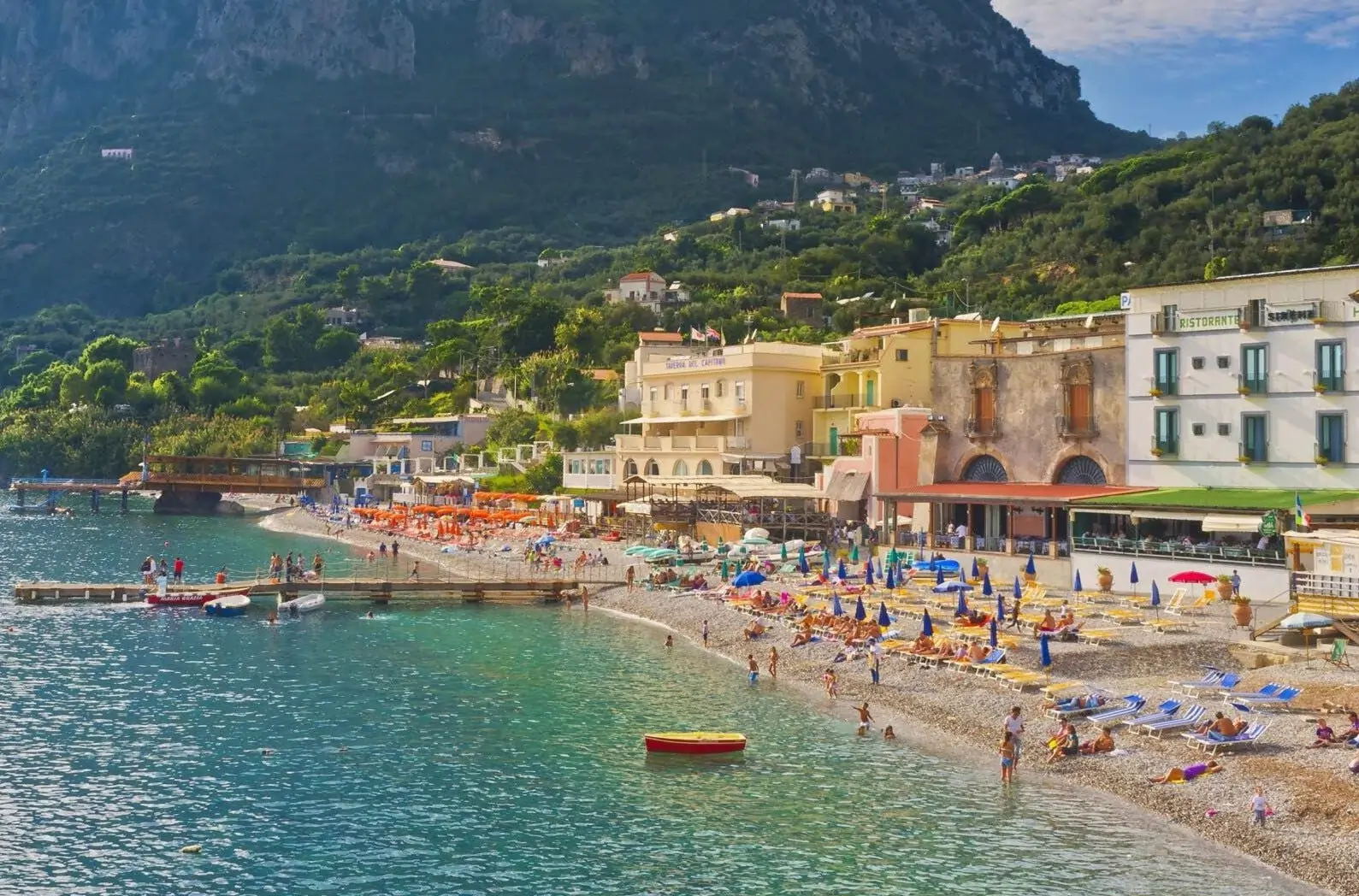
1 thought on “7 Best Summer Destinations in Europe Beach Lovers”